#Malin Space Science Systems
Explore tagged Tumblr posts
Text

JUPITER – JunoCam / 2024-09-20 Mission Phase : PERIJOVE 65
See more: https://jackiebranc.site/jupiter-and-its-galilean-moons/
Credit : NASA / SwRI / MSSS / Jackie Branc © CC BY
#elloon#jackie branc photographer#juno#juno spacecraft#jupiter#astronomy#nasa jpl#nasa#nasa photos#space exploration#jet propulsion laboratory#gas giant#solar system#Southwerst Research Institute#Malin Space Science Systems
48 notes
·
View notes
Photo

Happy Face Crater on Mars
Credits: Malin Space Science Systems, MGS, NASA
312 notes
·
View notes
Text
News
NASA's Mars Perseverance snaps a selfie as a Martian dust devil blows by
By MARCIA DUNN, AP Aerospace WriterUpdated May 21, 2025 12:32 p.m.
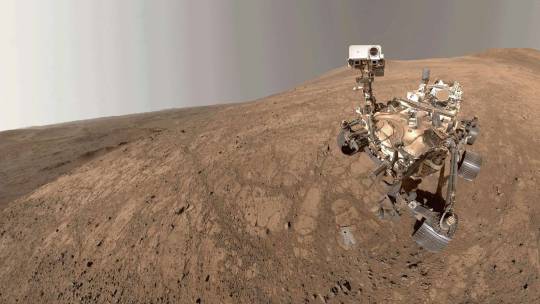
This image provided by NASA shows Perseverance taking a selfie on May 10, 2025. (NASA via AP)AP
CAPE CANAVERAL, Fla. (AP) — The latest selfie by NASA's Perseverance rover at Mars has captured an unexpected guest: a Martian dust devil.
Resembling a small pale puff, the twirling dust devil popped up 3 miles (5 kilometers) behind the rover during this month’s photo shoot. Released Wednesday, the selfie is a composite of 59 images taken by the camera on the end of the rover’s robotic arm, according to NASA.
It took an hour to perform all the arm movements necessary to gather the images, “but it's worth it,” said Megan Wu, an imaging scientist from Malin Space Science Systems, which built the camera.
“Having the dust devil in the background makes it a classic," Wu said in a statement.
The picture — which also shows the rover's latest sample borehole on the surface — marks 1,500 sols or Martian days for Perseverance. That's equivalent to 1,541 days on Earth.
Perseverance is covered with red dust, the result of drilling into dozens of rocks. Launched in 2020, it’s collecting samples for eventual return to Earth from Jezero Crater, an ancient lakebed and river delta that could hold clues of any past microbial life.
6 notes
·
View notes
Text
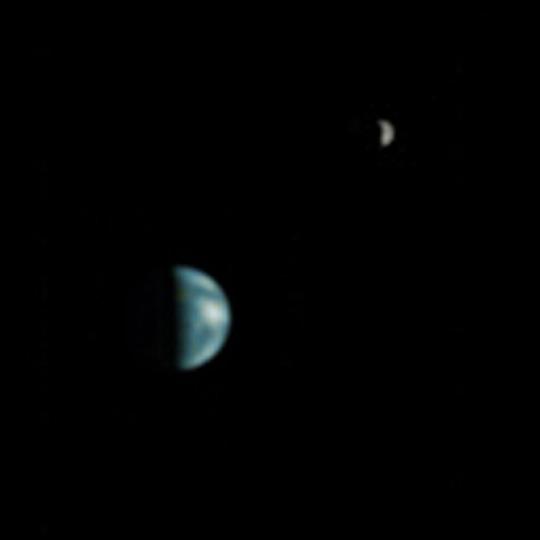
Earth and Moon as viewed from Mars
Image Credit: NASA/JPL/Malin Space Science Systems
7 notes
·
View notes
Text
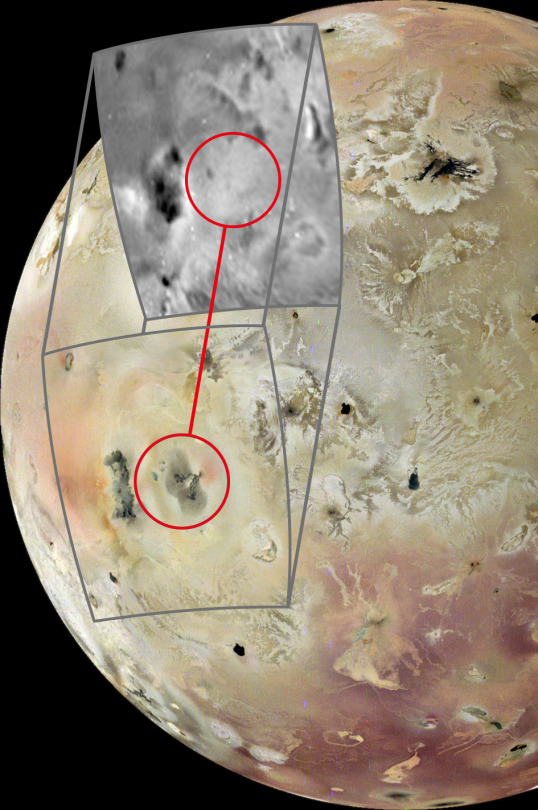

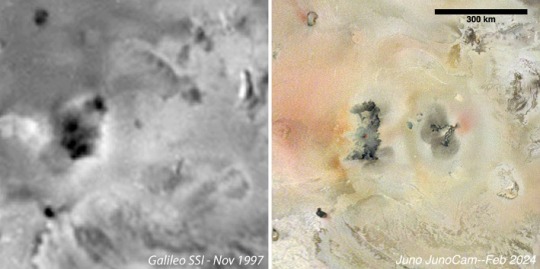
JunoCam Spots New Volcano on Active Io
A new volcano has been spotted on Jupiter’s moon Io, the most geologically active place in the Solar System. Analysis of the first close-up images of Io in over 25 years, captured by the JunoCam instrument on NASA’s Juno mission, reveal the emergence of a fresh volcano with multiple lava flows and volcanic deposits covering an area about 180 kilometres by 180 kilometres. The findings have been presented at the Europlanet Science Congress (EPSC) in Berlin this week.
The new volcano is located just south of Io’s equator. Although Io is covered with active volcanoes, images taken during NASA’s Galileo mission in 1997 did not see a volcano is in this particular region – just a featureless surface.
“Our recent JunoCam images show many changes on Io, including this large, complicated volcanic feature that appears to have formed from nothing since 1997,” said Michael Ravine, Advanced Projects Manager at Malin Space Science Systems, Inc, which designed, developed and operates JunoCam for the NASA Juno Project.
The eastern side of the volcano is stained a diffuse red from sulphur that has been vented by the volcano into space and fallen back onto Io’s surface. On the western side, two dark streams of lava have erupted, each running for about a hundred kilometres. At the farthest point of the flows, where the lava has pooled, the heat has caused the frozen material on the surface to vaporise, generating two overlapping grey circular deposits.
The best JunoCam image of this feature, east of an existing volcano called Kanehekili, was taken on 3 February 2024 from a distance of 2,530 kilometres and at a scale of 1.7 kilometres per pixel. The images were captured the nightside of Io with the illumination coming only from Jupiter.
This encounter was one of three recent flybys of Io in 2023 and 2024, during which JunoCam acquired around 20 close-up visible colour images. JunoCam observed a total of nine plumes associated with active volcanic features on the moon, as well as other changes, such as new lava flows and other surface deposits.
TOP IMAGE: A comparison of JunoCam data from April 2024 with imagery from the Galileo mission of the same area in November 1997 (greyscale insert) reveals a new volcanic feature on the surface of Jupiter’s moon, Io. Credit: NASA/JPL-Caltech/SwRI/MSSS/Europlanet.
CENTRE IMAGE: JunoCam’s 3 February 2024 Io encounter sequence of images (the first two images show Io illuminated by Jupiter-shine). The new volcano discussed above was captured in the second image in the sequence. Credit: NASA/JPL-Caltech/SwRI/MSSS.
LOWER IMAGE: A side-by-side comparison of JunoCam data from April 2024 (left) with Galileo spacecraft imagery of the same area in November 1997 (right), reveals a new volcanic feature on the surface of Jupiter’s moon, Io. Credit: NASA/JPL-Caltech/SwRI/MSSS.
2 notes
·
View notes
Text
A Dust Devil Photobombs Perseverance!
Mars 2020 Mission Team Members May 29, 2025 Written by Athanasios Klidaras, Ph.D. candidate at Purdue University, and Megan Kennedy Wu, Senior Mission Operations Specialist at Malin Space Science Systems To celebrate her 1,500th Martian day (“Sol”) exploring the red planet, the Perseverance rover used its robotic arm to take a selfie of the rover and the surrounding landscape. But when team…
0 notes
Text
A DustDevil Photobombs Perseverance!
Written by Athanasios Klidaras, Ph.D. candidate at Purdue University, and Megan Kennedy Wu, Senior Mission Operations Specialist at Malin Space Science Systems To celebrate her 1,500th Martian day (“Sol”) exploring the red planet, the Perseverance rover used its robotic arm to take a selfie of the rover and the surrounding landscape. But when team members […] from NASA https://ift.tt/9aPiIbs
1 note
·
View note
Text
Sols 4507-4508: “Just Keep Driving”
Written by Natalie Moore, Mission Operations Specialist at Malin Space Science Systems Earth planning date: Wednesday, April 9, 2025 Our drive from Monday’s plan was mostly successful, putting us ~22 meters down the “road” out of an expected 30 meters. A steering command halted the drive a little short when we tried to turn-in-place but […] Continue reading Sols 4507-4508: “Just Keep Driving”
0 notes
Text
Moons of Kavrillia
I've long said that when I made up Kavrillia's moons I basically stole Earth's Moon and Mars' Phobos and Deimos and stuck them in orbit around my planet.
Messing around on Wikipedia, I found a cool image by NASA/JPL-Caltech/Malin Space Science Systems/Texas A&M University.
On the left, the sizes of the three satellites in question, as seen from the surface of their respective planets.
On the right is how Kavrillia's moons appeared once on Zenni's T-shirt.


I didn't realize there was such a difference in apparent size between Phobos and Deimos! They're not that different in actual size, but Deimos is much further from the planet than Phobos.
The Lanarians call their largest moon the Sky Pearl, but I've never named the two smaller ones. That's a gap in my worldbuilding I really should fill some time. The Vincarans think of the moons as the eyes of a couple of their gods, so I imagine they just call them "So-and-so's Eye."
Other food for thought from Wikipedia: Phobos is inching closer to Mars all the time and will someday break up, with some chunks falling to the planet and others forming a ring around it. Deimos is slowly moving away from Mars and will someday escape its gravity. I like to think Kavrillia's moons are more stable than that, although nothing is going to happen to them during the timeframe of my writing, either way. (Just like Mars will continue to have two moons in the real world for far longer than any of us will be around to see them.)
Due to the angle of its orbit, Deimos is not visible from the surface of Mars if you're above 82.7 degrees of latitude. I never thought about that being a thing. I wonder if all three of Kavrillia's moons are visible all over the planet (and if not, how Vincarans reconciled that with their mythology. Ainia is winking?)
As for Phobos, to quote Wikipedia, "from the point of view of an observer on the surface of Mars, it rises in the west, moves comparatively rapidly across the sky (in 4 h 15 min or less) and sets in the east, approximately twice each Martian day (every 11 h 6 min)."
Deimos rises in the east and sets in the west, the opposite of Phobos, and takes about 2.5 days to cross the sky. From the surface of Mars, it appears to be about 1/12th of the width of Earth's Moon, i.e. it looks more like Venus or Vega does to us here. Definitely not big enough to put on a T-shirt!
So I guess I didn't copy from the real world as closely as I thought I did. Which is fine! Kavrillia is a fictional planet, so it can have whatever characteristics I want.
The calendar maker at World Anvil has options to track moons of varying periods, and I entered pretty random figures when I made a rough draft of the Melzeen calendar. That calendar isn't canon (yet), but knowing a bit more about how real moons work should help with the next revision.
Not that anyone is ever going to think about this in as much detail as I am. ;)
1 note
·
View note
Text
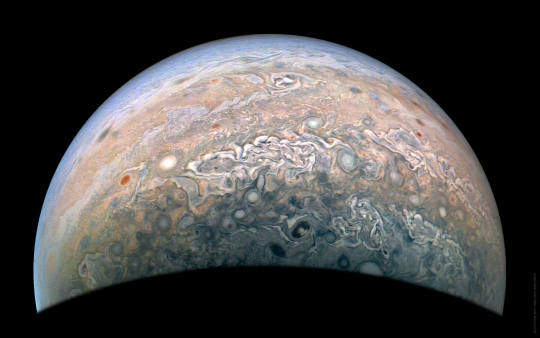
JUPITER – JunoCam / 2024-08-18 Mission Phase : PERIJOVE 64
See more: https://jackiebranc.site/jupiter-and-its-galilean-moons/
Credit : NASA / SwRI / MSSS / Jackie Branc © CC BY
#elloon#jackie branc photographer#juno#juno spacecraft#jupiter#astronomy#NASA#jet propulsion laboratory#astrophysics#junocam#gas giant#solar system#Southwest Research Institute#Malin Space Science Systems
8 notes
·
View notes
Photo
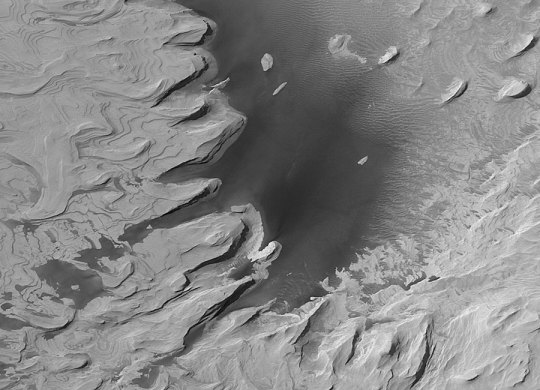
Ancient Layered Hills on Mars
Credits: Malin Space Science Systems, MOC, MGS, JPL, NASA
81 notes
·
View notes
Link
The photo shows Shackleton Crater NASA presented an image of the Shackleton crater, which is located at the South Pole of the Moon The image was created based on images obtained by the LROC (Lunar Reconnaissance Orbiter Camera), which has been operating since 2009, and the ShadowCam module on board the South Korean Danuri satellite, which was launched in August 2022. ShadowCam was developed by Malin Space Science Systems and Arizona State University. LROC can take detailed images of the lunar surface but has limited ability to capture images of the shadowed part of the Moon, which never receives direct sunlight. ShadowCam is 200 times more light-sensitive than LROC and can operate successfully in extremely low light conditions, revealing terrain features and details that are not visible to LROC. ShadowCam uses sunlight reflected from geological features on the Moon or Earth to capture images in shadows. [caption id="attachment_58069" align="aligncenter" width="600"] NASA[/caption] However, ShadowCam's light sensitivity prevents it from capturing images of parts of the Moon that are directly illuminated. Because each camera is optimized for specific lighting conditions near the lunar poles, analysts can combine images from both instruments to create a comprehensive visual map of the terrain and geologic features of both the brightest and darkest parts of the Moon. With ShadowCam, NASA can examine in detail the permanently shadowed areas of the Moon, giving scientists a much better view of the Moon's South Pole region. This area has never been explored by humans and is of great interest to science and research because it is believed to contain deposits of ice or other frozen volatiles. Scientists believe layers of icy sediment have existed on the Moon for millions or billions of years, and the ability to study the samples could contribute to our understanding of how the Moon and our solar system evolved. Ice deposits can also serve as an important resource because they are composed of hydrogen and oxygen, which can be used as rocket fuel or life support systems.
#astronaut#astronomy#Mars_exploration#NASA#National_Aeronautics_and_Space_Administration#rocket_science#space_agency#space_exploration#space_missions#space_research#space_science#spacecraft
0 notes
Photo

The Galle Crater on Mars, aka the Happy Face Crater, imaged by NASA’s Mars Reconnaissance Orbiter on January 28, 2008.
(Malin Space Science Systems)
662 notes
·
View notes
Text

See NASA’s Curiosity Rover’s Stunning 360-Degree View Atop “Mont Mercou” on Mars
NASA’s Curiosity Mars rover took this 360-degree panorama while atop “Mont Mercou,” a rock formation that offered a view into Gale Crater below. The panorama is stitched together from 132 individual images taken on April 15, 2021, the 3,090th Martian day, or sol, of the mission. The panorama has been white-balanced so that the colors of the rock materials resemble how they would appear under daytime lighting conditions on Earth.
The rover’s Mast Camera, or Mastcam, provided the panorama. Malin Space Science Systems in San Diego built and operates Mastcam. A division of Caltech, NASA’s Jet Propulsion Laboratory in Southern California built the Curiosity rover and manages the Curiosity rover for the agency’s Science Mission Directorate in Washington.
8 notes
·
View notes
Photo

Phobos This magnificent shot is one of the highest-resolution images of Mars’s moon Phobos ever taken, with a resolution of 4 meters/pixel. It was originally collected in 1998 by the Mars Orbiter Camera on the US Mars Global Surveyor spacecraft. Phobos itself is about 11 kilometers in diameter and the large crater you can see on one side is about 10 kilometers in diameter – nearly the size of the moon itself.
If you look closely, there are boulders on the edge of the crater, possibly ejected when the crater formed, and trails of pits that seem to move away from the crater. The exact cause of these pits is not currently known; they have been hypothesized to be ejecta from the impact, fractures created due to tidal stresses associated with Mars, or even craters formed from debris ejected from Mars itself in a large impact. The large crater is named Stickney after Chloe Angeline Stickney Hall, wife of the discover of Phobos Asaph Hall. Angeline Stickney was herself educated and an instructor, as well as a 19th century supporter of votes for women and the abolition of slavery in the United States. When she married she gave up her career, but continued to work in astronomy and offer support to her husband somewhat. Many couples of scientists at the time worked together but only had credit go to the man in the relationship, but in this case she requested comparable pay to continue doing astronomical calculations and stopped assisting after Asaph Hall refused her request. -JBB Image credit: Nasa/JPL/Malin Space Science Systems https://photojournal.jpl.nasa.gov/catalog/PIA01333 Reference: https://web.archive.org/web/20120826235010/http://maia.usno.navy.mil/women_history/hall.html
#Phobos#moon#mars#science#crater#stickney#women in science#history#abolitionist#nasa#planetary science#the universe#the real universe
33 notes
·
View notes